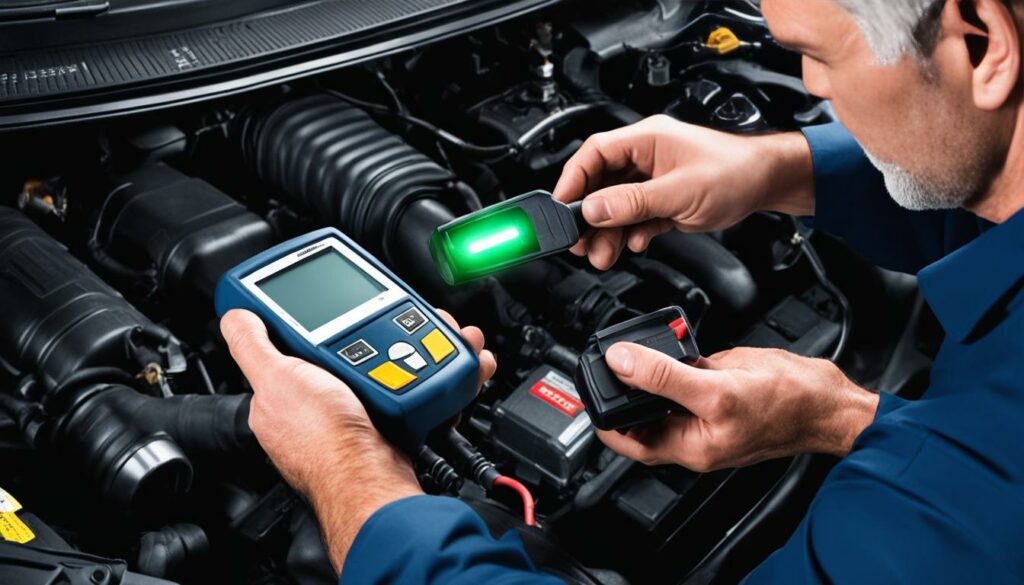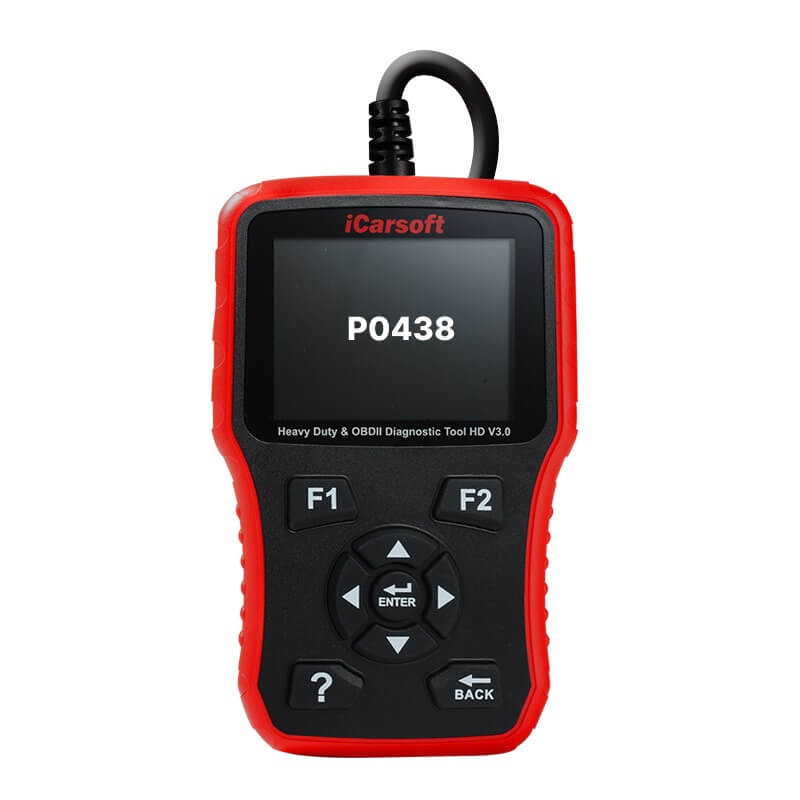P0438 – Catalyst Temperature Sensor High Bank 2
POSTED IN pcodes
Welcome to our article on the P0438 code, specifically related to the Catalyst Temperature Sensor High Bank 2. If you’ve encountered this code, it’s important to understand its implications and how to diagnose and fix the issue. In this article, we will provide you with a comprehensive guide to help you troubleshoot and resolve the P0438 code.
When your vehicle’s PCM stores trouble code P0438, it indicates that the catalyst efficiency is below the proper operational threshold for engine bank 2. This code is typically caused by a problem with the catalytic converter or defective oxygen sensors. Symptoms may include a decrease in engine performance, hesitation while accelerating, or stalling.
Key Takeaways:
- The P0438 code indicates an issue with the catalyst efficiency of engine bank 2.
- Symptoms may include decreased engine performance, hesitation while accelerating, or stalling.
- Diagnosing the P0438 code requires the use of a scanner, volt/ohmmeter, and temperature gun.
- Common mistakes when diagnosing P0438 include not investigating the cause of catalytic converter failure and replacing oxygen sensors without proper verification.
- Consulting with a professional mechanic is recommended for accurate diagnosis and repair.
P0438 Code Definition
The P0438 code indicates that the catalyst efficiency is below the proper operational threshold for engine bank 2. It is typically caused by a problem with the catalytic converter or defective oxygen sensors. The code is a generic powertrain code that applies to OBD-II equipped vehicles.
When the catalyst efficiency falls below the operational threshold, it means that the catalytic converter is not effectively reducing harmful emissions. This can lead to increased pollution and may also result in decreased engine performance.
Engine bank 2 refers to the specific side of the engine where the issue is detected. In a V6 or V8 engine, engine bank 2 typically refers to the side opposite the bank with the number 1 cylinder.
Buy tested tuning file for Adblue / EGR / DPF / Adblue off now!
Oxygen sensors play a crucial role in the proper functioning of the catalytic converter. They monitor the oxygen content in the exhaust gases and provide feedback to the engine management system to adjust the air-fuel mixture. If the oxygen sensors are faulty or not functioning properly, it can impact the catalyst efficiency and trigger the P0438 code.
Emissions and catalyst efficiency are essential factors in achieving environmental compliance and optimal engine performance. Promptly addressing the P0438 code and resolving any issues with the catalytic converter or oxygen sensors is crucial to ensure the vehicle runs efficiently and meets emission standards.
Next, we’ll explore the symptoms that may indicate the presence of the P0438 code.
Symptoms of the P0438 Code
The P0438 code can manifest through several distinct symptoms. It is imperative to identify these symptoms promptly to prevent further damage to your vehicle.
Some common symptoms of the P0438 code include:
- An illuminated check engine light
- Poor engine performance
- Decreased fuel economy
- Increased emissions
- Hesitation while accelerating
- Stalling
If you notice any of these symptoms, it is crucial to address the P0438 code as soon as possible. Ignoring the issue can lead to further deterioration of engine performance and potentially cause other related problems.

Example Diagnostic Example
“When my check engine light came on, I experienced a noticeable decrease in engine performance. The car hesitated during acceleration and even stalled on occasion. I knew something was wrong and immediately took it to a mechanic to diagnose the issue.”
| Symptom | Description |
|---|---|
| Check Engine Light Illuminated | The check engine light will turn on to alert the driver of a potential issue. |
| Poor Engine Performance | The engine may run rough, lack power, or have difficulty maintaining consistent speed. |
| Decreased Fuel Economy | The vehicle may require more fuel to operate efficiently, leading to decreased fuel efficiency. |
| Increased Emissions | The vehicle may produce higher levels of harmful exhaust emissions. |
| Hesitation While Accelerating | The engine may exhibit hesitation or a delay in response when the accelerator pedal is pressed. |
| Stalling | The engine may unexpectedly shut off or stall while driving or idling. |
Diagnosing the P0438 Code
When faced with the P0438 code, proper diagnostic procedures are crucial to pinpoint the root cause of the issue. To accurately diagnose the P0438 code, skilled mechanics employ a combination of diagnostic tools and techniques, including:
- Scanner: A scanner is used to retrieve the stored trouble code and other relevant data from the vehicle’s onboard computer.
- Volt/Ohmmeter: This tool is utilized to measure electrical voltage and resistance, helping mechanics test the catalytic converter and oxygen sensors.
- Temperature Gun: By using a temperature gun, mechanics can assess the temperature of the catalytic converter and compare it to the manufacturer’s specifications.
During the diagnostic process, mechanics will thoroughly examine the connectors and wiring associated with the catalyst temperature sensor and oxygen sensors. If any damage or faulty connections are found, they will be repaired or replaced accordingly. Once any necessary repairs have been made, the system will be re-tested to ensure the issue has been resolved.
Additionally, the diagnostic process may involve comparing the findings with the specifications provided by the vehicle manufacturer. This helps mechanics identify any discrepancies that may contribute to the P0438 code. To further validate the diagnosis, a test drive may be performed to observe if the symptoms associated with the P0438 code reappear.

Through a comprehensive diagnostic approach using advanced tools and techniques, mechanics can accurately diagnose the P0438 code and determine the most appropriate course of action for repair.
Common Mistakes When Diagnosing the P0438 Code
When diagnosing the P0438 code, it is important to avoid common mistakes that can lead to ineffective repairs and wasted time. By understanding these mistakes, you can ensure a successful diagnosis and resolution of the issue.
1. Not Properly Investigating Catalytic Converter Failure
One of the most common mistakes when diagnosing the P0438 code is failing to thoroughly investigate the cause of catalytic converter failure. The catalytic converter plays a vital role in reducing harmful emissions and improving overall vehicle performance. Ignoring potential issues or only addressing the symptoms without identifying the underlying cause can lead to recurring problems and further damage to the converter.
It is essential to thoroughly inspect the catalytic converter for signs of damage, such as physical cracks or clogs due to excessive carbon buildup. Additionally, testing the airflow and exhaust system can help pinpoint any issues affecting the converter’s proper function.
2. Replacing Oxygen Sensors Without Verification
Another common mistake is replacing the oxygen sensors without verifying that they are truly faulty. Oxygen sensors play a crucial role in monitoring the vehicle’s exhaust gases and providing data to the engine control module for optimal fuel-air mixture. Faulty oxygen sensors can affect the fuel-air ratio and lead to poor performance and increased emissions.
Before replacing the oxygen sensors, it is recommended to perform diagnostic tests to determine their functionality. This typically involves using a voltmeter or scan tool to check for irregular voltage readings or slow response times. By verifying the faulty sensors, you can avoid unnecessary expenses and ensure an accurate repair.
3. Choosing Inadequate Catalytic Converter Replacement
Opting for a cheaper, rebuilt catalytic converter is another common mistake made during the diagnosis of the P0438 code. While the allure of cost savings may be tempting, it is important to consider the long-term consequences of installing a low-quality converter.
A subpar catalytic converter may not provide the same level of efficiency and durability as an OEM (Original Equipment Manufacturer) converter. It may fail prematurely or not meet emission standards, leading to recurring issues and potential fines during vehicle inspections.
When replacing the catalytic converter, it is recommended to choose an OEM or high-quality aftermarket converter that meets or exceeds the vehicle manufacturer’s specifications. This ensures optimal performance and compliance with emission regulations.
Conclusion
The P0438 code signifies a problem with the catalyst efficiency of engine bank 2. It is crucial to address this issue promptly to prevent further damage to your vehicle. Depending on the specific diagnosis, repairs may entail replacing the oxygen sensors or the catalytic converter.
If the oxygen sensors are faulty, it is recommended to replace them to ensure accurate readings and optimal engine performance. On the other hand, if the catalytic converter is the culprit, a replacement may be necessary to restore proper catalyst efficiency.
It is highly advised to consult with a professional mechanic who specializes in diagnosing and repairing engine codes such as P0438. They have the expertise and tools to accurately pinpoint the underlying cause and provide the appropriate repairs. By entrusting your vehicle to a qualified mechanic, you can ensure that the P0438 code is resolved effectively and efficiently.
FAQ
What does the P0438 code mean?
The P0438 code indicates that the catalyst efficiency is below the proper operational threshold for engine bank 2. It is typically caused by a problem with the catalytic converter or defective oxygen sensors.
What are the symptoms of the P0438 code?
Symptoms may include a decrease in engine performance, hesitation while accelerating, stalling, an illuminated check engine light, poor fuel economy, and increased emissions.
How is the P0438 code diagnosed?
To diagnose the P0438 code, a mechanic will typically use a scanner, volt/ohmmeter, and temperature gun. They will examine the connectors and wiring, replacing or repairing anything that is damaged. The system will be re-tested following any repairs.
What are the common mistakes when diagnosing the P0438 code?
The most common mistakes include not properly investigating the cause of catalytic converter failure, replacing the oxygen sensor without verifying its faultiness, and opting for a cheaper, rebuilt catalytic converter that may not perform as well as an OEM converter.
What repairs are needed for the P0438 code?
Repairs may include replacing the oxygen sensors or the catalytic converter. It is recommended to consult with a professional mechanic to accurately diagnose and fix the P0438 code.


